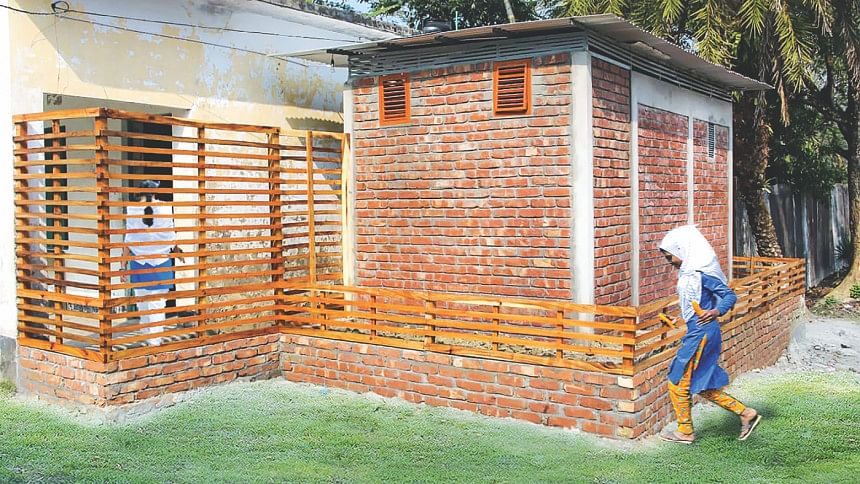Changing the shy world of adolescent girls

Back in 2017, we had an opportunity to build a small and experimental toilet in Jhalokati, with the simple intention of helping adolescent girls in a rural school who had no real toilet to avail. We designed a cost-efficient, environment-friendly, safe, and sanitary toilet for them to access easily and to improve their menstrual hygiene. We also wanted to help them change their common perception of a toilet from a dark, dingy, and stigmatised space to a positive, light-filled, ventilated, and gender-friendly facility.
The toilet project soon evolved into a research topic, an opportunity to look at some of the typical social and hygiene-related problems that rural girls encounter at their schools. Our hope was that this prototype toilet project would change the attitudes of school teachers, parents, local community leaders, and even adolescent boys regarding specific health needs of girls. Furthermore, a gender-friendly toilet would improve the self-esteem of girls, enabling them to become more conscious and productive citizens.
It was a significant learning experience. We gained insight into how hygiene, adolescence, and social conditions intersect, while encountering a host of surprising repercussions in project management. In Bangladesh, 40 percent of adolescent girls do not attend school during the first three days of their period. Only 11 percent of schools have separate toilets for girls with water facilities, 3 percent have the facility to dispose of sanitary products, and 69 percent of school girls never change sanitary napkins during school time. About 45 percent of girls complain about the unavailability of water in school toilets. According to the Bangladesh National Hygiene Baseline Survey-2014, only 10 percent of students use disposable pads and only 12 percent schools have improved toilets for girls. Most of the time school girls use rags instead of sanitary napkins, resulting in urinary infections. This situation leads to a pervasive culture of school absenteeism among adolescent girls, eventually creating unfortunate conditions for many to drop out from school. Subsequently, the evil of underage marriage rushes in.
During the course of our toilet design, we realised that research on girls' hygiene management as well as its influence on their education and well-being is scarce. Moreover, very little has been done to improve design guidelines and placement of toilets within a given school premise that specifically supports adolescent girls' special needs. Often times young girls never receive accurate information, guidance, and access to affordable sanitary options.
We came to the realisation that inadequate access to a comfortable, convenient, and secure toilet at schools is one of the most common forms of gender discrimination, experienced regularly by girls across rural Bangladesh. The most troubling part of this discrimination is that it occurs due to the community's pervasive apathy and unwillingness to address the issue. Menstruation is a taboo subject and everybody wants to avoid having to discuss it. Although considerable effort has been undertaken by NGOs and community groups to ameliorate the situation, there is still silence both at school and home. Neither parents nor teachers take necessary steps to educate girls on the subject. This form of silence, further complicated by societal ignorance of and indifference to menstrual hygiene, breeds a fertile ground for discrimination and denigration.
We recently completed the construction of the toilet that we proposed back in 2017. A core concept of our toilet design was "no girl alone." Often times girls feel reluctant to go to the solitary toilet facility at school because they are afraid that they would be harassed on the way to or once inside the toilet. Our solution for this particular problem was to provide three functions—toilets, ablution space, and handwashing—so that multiple girls can be inside the facility at the same time as mutual protection. The toilet includes a low-cost, key-based sanitary pad dispenser. Furthermore, our design proposes to use waste water for the adjacent community vegetable garden that the girls will be responsible for maintaining. This way they will take ownership of the toilet, thereby feeling inspired to sustain it as best as they can. Maintenance of the facility in small teams is their responsibility.
Just because one has a good, philanthropic intention doesn't mean that people at the receiving end will accept something with open arms: in fact, there were serious obstacles. The toilet project required a monumental effort to get it approved by the omnipotent school committee. We first suggested a precondition that the local community would pay 10 percent of the total construction cost; a partial community ownership would mean better monitoring and maintenance of the facility. But the suggestion was met with dead silence!
The divisiveness of the school committee was forbidding. Not everyone agreed that a toilet for girls was even necessary. So much attention devoted to girls was perhaps unacceptable. Eventually, the committee agreed on the necessity of a gender-friendly toilet on the school premise and approved it. However, in the meeting minutes, the clause for the 10-percent community contribution toward the construction cost was surreptitiously deleted.
Once the construction of the toilet began, local goons arrived to demand money from the contractor, who couldn't oblige because it was a small project with very little room for profit. His plea didn't soften the goons; they returned at night and destroyed the under-construction toilet. We were shattered. How could people be so insensitive and heartless? We approached the local political power-wielders and appealed for intervention. After multiple telephone calls and police visits to the school, things were under control, thanks to our "connection." The toilet finally came to reality after much consternation and high drama. This is only the first part of the story.
We recognise that the toilet may change neither the misogynist culture of a rural school nor the shy world of adolescent girls. The toilet may even fall into disrepair and become a putrid place as elsewhere. To stop that from happening, we thought it would be important to tie the idea of toilet hygiene with curricular reform in such subjects as civic responsibility, environmental sustainability, gender studies, and conscientious use of water. These ideas, even if they are executed at a micro-scale, are intimately related to the nation's broader interests because school girls will emerge as better human beings and, as mothers, also enlighten their progeny. We also believe that our small project can spur local initiatives for not just public health and wellbeing, but also social justice. We will continue to study the girls' response to the toilet facility as an everyday frontier to change society, one step at a time.
Syed Saad Andaleeb, PhD, is a Distinguished Visiting Professor, IBA, University of Dhaka, and former Vice Chancellor of BRAC University. Adnan Zillur Morshed, PhD, is Executive Director of the Centre for Inclusive Architecture and Urbanism at BRAC University, and professor at the Catholic University of America in Washington, DC.
Architects S.M. Shafaiet Mahmud, Tahseen Reza Anika, Faizal Bin-Afzal Ash-Shafi, and Aarijah Rashid participated in the design of the toilet.


 For all latest news, follow The Daily Star's Google News channel.
For all latest news, follow The Daily Star's Google News channel. 



Comments